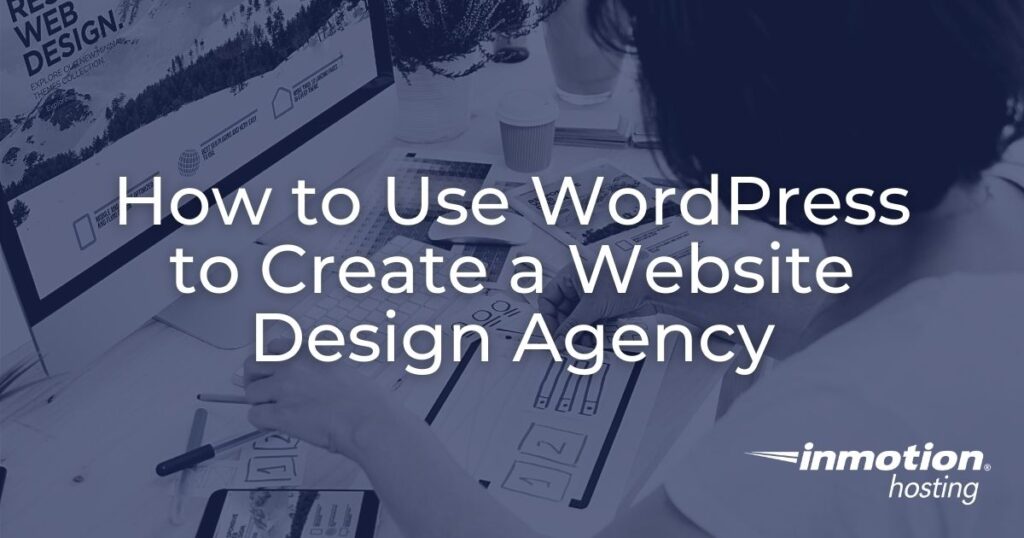
WordPress is user-friendly, easy to learn, and free to use. It’s no wonder that more than 33 percent of the world’s websites are built using it.
Despite its ease of use and other great advantages, some people and businesses just don’t have the time, knowledge, or experience to design and build their own website.
That’s where developers and website design teams can come to the rescue. Teams of developers like InMotion Hosting’s Website Design Services team can take a customer idea and turn it into their perfect WordPress site.
But taking a customer idea from concept to finished product is no easy task, and doing so works best when you have a diverse team to split the workload.
We sat down with developers Steven Llano and Brandy Fetzner of our Website Design Services team to see how they use WordPress to design custom sites for clients like agencies.
Steven oversees projects from start to finish and handles front end design, and Brandy works with customers to code websites on the back end to fit their exact needs.
How long has Web Design Services been using WordPress for website design and development?
Steven: I’ve been a leader of this team and with the company for about three years. Since my onboarding, the team has been using WordPress for website development, but they have gone as far back as at least a ten years using this content management system.
Why do you think WordPress is a great tool for both new users and web design agencies?
Steven: I come from a background in design and startups. Being around communities like this meant we were always experimenting with ideas, and many of our ideas would likely fail. But that was okay, because we’d learn lessons to apply and try again. WordPress is an excellent tool because it offers so much flexibility for the new and skilled alike. With it powering over 33 percent of the world’s sites, you are bound to find a web builder tool, theme, or plugin(s) to make your site come alive with minimal coding skills. But if you do have the technical knowledge, then more power to you to take it to even greater heights if you need to. With such ease of being able to put together a website, it’s easy to use the platform as a form of experimentation and testing new ideas in the market. This could be a website presented as a business concept, or an idea or solution presented online. Instead of spending years thinking of what if, you can put this online quickly and let the world tell you if it’s a hit or miss. I like that about this platform.
What is the workflow for site creation with WordPress? Does your team use a custom template?
Steven: I inherited a workflow that existed among the team, but we’ve modified it some over time. Another perk with WordPress is that you are never bound to how things are today – you can always tweak things as you go and perfect them per team or client feedback. Currently, our workflow is to mockup a website idea or concept in Adobe Photoshop. You can use other tools like Adobe Illustrator, Adobe XD, or other mockup tools that are gaining popularity like UXPin, Figma, Sketch, etc. We then present this mockup to the customer to gather their feedback. We do this for three rounds, and then proceed to taking the approved final version of the mockup to coding. Our designer will slice all of the elements and zip them up, and our coder will structure them in WordPress using a custom in-house theme.
Brandy: Once Steven and the design team have handed the final design to me, my team and I will build the website from the ground up. We use our custom WordPress theme, but everything is modified to fit the customer’s request. We really like our theme because of how customizable and flexible it is, which allows us to accommodate almost any design layout. Unlike many paid themes, our themes are not limited. Our theme can be easily modified for look and feel to basically do whatever you want possible in the realm of zeroes and ones.
What design elements does your team use to ensure every client has a fresh WordPress website design within the general restrictions/guidelines of WordPress?
Steven: As far as the design elements we use consistently, we have the hero section, clear CTA’s (call to actions), stock images (high resolution/professional), sliders, we also play with different fonts, space, and contrasting colors.
Brandy: Our goal is to use these elements to create websites that are impactful and engaging, and tell the user what to do next. We use fonts and colors to capture interest, and sliders and CTAs to capture their attention and give them something to interact with, as well as condense information.
What go-to plugins does your team add to client sites? Why?
Brandy: I’ve listed some of my favorite plugins below because they are easy to use and make my job easier, but as far as the plugins we add to client sites, that’s entirely dependent on their individual needs. Our team will vet plugins based on star ratings, installations, when it was last updated, and what people are saying about it in the forums to compile a list of reliable plugins, but the plugins that go on a customer’s site are always curated based upon their needs.
Here are a few of my favorite plugins and why I like them:
- Enable Media Replace (By ShortPixel) – Allows you to replace images in the media manager and updates all instances of the image on the site with the new, modified image. (Prevents you from having to scour the pages of the site to look for all instances of the image.)
- Google Analytics for WordPress (By MonsterInsights) – Shows how visitors find and use your website.
- iThemes Security (By iThemes) – Robust security plugin that helps guard against unauthorized users from logging in to the dashboard.
- TablePress (By Tobias Bathge) – Creates beautiful tables for content without having to know code.
- W3 Total Cache (By BoldGrid) – Dramatically improve the speed and user experience of your site. Adds browser, page, object and database caching.
- weForms (By weForms) – Easy to use and style, free version works for most forms. Paid version adds even more functionality.
- WooCommerce (By Automattic) – Free, robust eCommerce solution for WordPress. Must be supported by the chosen theme.
What best practices do you promote within your team to ensure a great WordPress website design experience for your clients?
Steven: From a front end design perspective, we like to clearly chunk information into bite size pieces, utilize great imagery and provide indications of what the next steps are. Customers will send in a lot of info, so we practice breaking it up and making it easier to read and scan. We l
ike to tell the user what to do next, and make it clear, after they engage with this page, this is what you want them to do next. This helps to increase user engagement and improve their experience on our customers websites.
Brandy: One of the best practices we have on the backend is providing customer walkthroughs via video tutorials. We introduce a customer to their site where we have them engage with their dashboard and make some changes themself so they get comfortable and familiar with their site. In the walkthrough we will show them how to do things like create posts and pages, add customer testimonials, update plugins, as well as remind them to regularly backup their site when making changes. We also save the video of the walkthrough and share it with them as a sort of custom tutorial on how to use their site.
What happens after launch? How do you promote a positive WordPress experience after the project is completed?
Brandy: After we launch their website, clients can opt-in to our maintenance plans or White Glove services. With recurring maintenance, we can do things like update content, change slides for seasonal sales and pretty much anything else they could want from their own personal design team. White Glove services are more for one off requests. Customers can make a request and then we audit the request to assess if it’s in scope and provide a quote for the ask if so. We also provide the video tutorial post launch where we record a walkthrough of their site for them to save and share if they want to introduce new users to manage their site.
What advice would you give web designers and web design agencies looking to use WordPress to build client websites?
Steven: WordPress is a great tool to use for entry to expert level users. With plugins, themes, and builders, just about anyone can start a site. For success, I’d recommend connecting Google Analytics and tracking the traffic on the site and how it’s engaging with the site. A site is like a hypothesis in an experiment, you put out what you think will cater best to your target audience, but you need to measure it and tweak it over time to perfect it.
And don’t forget to look into the tons of resources online, as well for things like photos, videos, content creation, and even design resources for the non-designer (like Canva) to help create a cohesive brand. But if you can, also work with a design team that can help you manage the project from start to end, and deliver a product made to your needs.
Brandy: WordPress is great because there are plenty of available free and paid plugins to add a variety of flexibility and functionality to websites. Spend time finding the ones that are right for your needs. And I always recommend creating and modifying the site using a child theme so updates to the parent theme don’t affect the site design/functionality.

Steve Llano has been the Operations Supervisor for InMotion Hosting’s Web Design Services team for the past three years. He oversees projects from start to finish and considers his real job to be supporting the awesome team around him by helping them do their job. In his free time, he does private consulting and loves cooking and grilling as a way to round up his huge family and have a good time.

Brandy Fetzner has been with InMotion Hosting for nearly a decade and is currently the Senior Lead Front End Developer for the Web Design Services team. Her job involves taking the design from the designer and coding it into the perfect WordPress product for each individual customer. She enjoys horseback riding and quilting.
WordPress is constantly evolving! Stay up to date with the latest WordPress news and releases to keep your website modern and secure!
